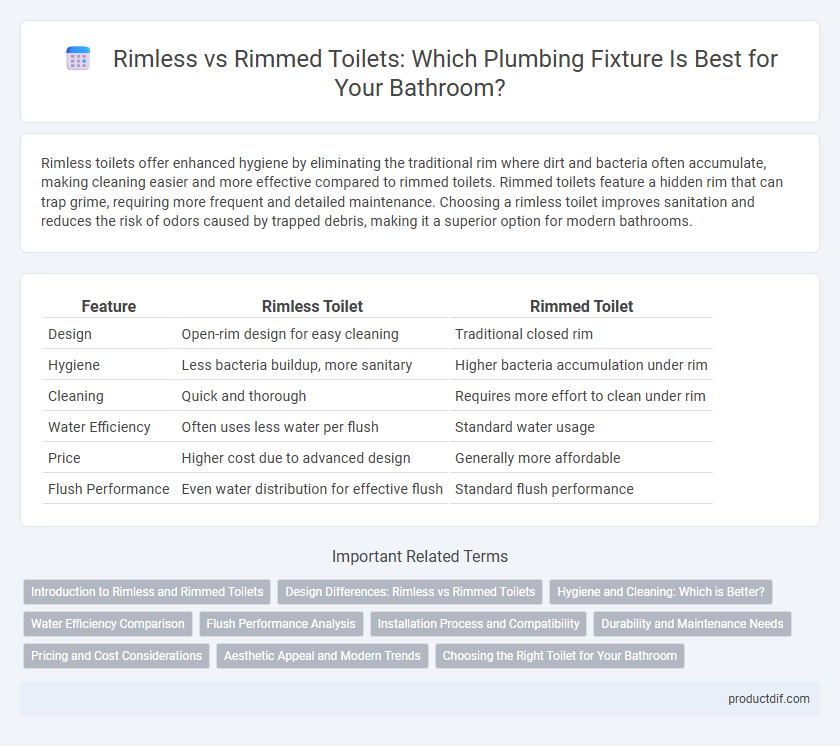Rimless toilets offer enhanced hygiene by eliminating the traditional rim where dirt and bacteria often accumulate, making cleaning easier and more effective compared to rimmed toilets. Rimmed toilets feature a hidden rim that can trap grime, requiring more frequent and detailed maintenance. Choosing a rimless toilet improves sanitation and reduces the risk of odors caused by trapped debris, making it a superior option for modern bathrooms.
Table of Comparison
| Feature | Rimless Toilet | Rimmed Toilet |
|---|---|---|
| Design | Open-rim design for easy cleaning | Traditional closed rim |
| Hygiene | Less bacteria buildup, more sanitary | Higher bacteria accumulation under rim |
| Cleaning | Quick and thorough | Requires more effort to clean under rim |
| Water Efficiency | Often uses less water per flush | Standard water usage |
| Price | Higher cost due to advanced design | Generally more affordable |
| Flush Performance | Even water distribution for effective flush | Standard flush performance |
Introduction to Rimless and Rimmed Toilets
Rimless toilets feature a flush design without the traditional inner rim, allowing water to flow directly from the bowl edge for superior hygiene and easier cleaning. Rimmed toilets have a visible rim with multiple holes that release water during flushing, offering effective coverage but often trapping dirt and bacteria underneath. Choosing between rimless and rimmed toilets depends on maintenance preferences, cleaning efficiency, and overall bathroom design.
Design Differences: Rimless vs Rimmed Toilets
Rimless toilets feature an open, rim-free design that facilitates easier cleaning and improved hygiene by preventing dirt and bacteria accumulation under the bowl's edge. Rimmed toilets have a traditional inner rim where water flows, which can harbor germs and require more thorough scrubbing. The sleek, modern design of rimless toilets offers a more streamlined appearance and enhanced flushing efficiency compared to the bulkier, conventional rimmed models.
Hygiene and Cleaning: Which is Better?
Rimless toilets offer superior hygiene due to the absence of a hidden rim where bacteria and dirt typically accumulate, making cleaning more efficient and thorough. Rimmed toilets often harbor grime beneath the rim, increasing the risk of bacterial growth and requiring more frequent, intensive cleaning efforts. Choosing a rimless toilet enhances bathroom sanitation by facilitating easier maintenance and reducing the buildup of harmful germs.
Water Efficiency Comparison
Rimless toilets use a direct flush system that reduces water usage by optimizing water flow, often requiring only 3 to 4 liters per flush compared to rimmed toilets that may use 6 liters or more. The absence of a rim allows rimless designs to clean more effectively with less water, enhancing overall water efficiency. This makes rimless toilets a preferred choice for reducing household water consumption and lowering utility bills.
Flush Performance Analysis
Rimless toilets offer superior flush performance by directing water evenly around the bowl, resulting in more efficient waste removal and easier cleaning compared to rimmed toilets. The absence of a rim eliminates hidden dirt traps, enhancing hygiene and reducing bacterial buildup. Rimmed toilets rely on water jets behind the rim, which can lead to uneven flush coverage and potential residue accumulation.
Installation Process and Compatibility
Rimless toilets offer a streamlined installation process due to their simpler design, which eliminates the need to clean and secure a rim, making them compatible with most standard plumbing systems. Rimmed toilets require precise alignment of the rim to ensure proper water flow and are compatible with traditional plumbing setups, but may need additional sealing to prevent leaks. Both types fit common bathroom layouts, yet rimless models often reduce installation time and maintenance requirements.
Durability and Maintenance Needs
Rimless toilets feature a design without the traditional inner rim, reducing areas where dirt and bacteria accumulate, resulting in easier cleaning and lower maintenance. Rimmed toilets have hidden grooves beneath the rim that can trap debris, requiring more frequent and thorough cleaning to maintain hygiene and prevent damage. In terms of durability, both types use high-quality ceramic materials, but rimless models often experience less wear over time due to improved hygiene and reduced buildup.
Pricing and Cost Considerations
Rimless toilets generally have a higher upfront cost compared to rimmed toilets due to their advanced design and easier cleaning features. Maintenance expenses tend to be lower for rimless models as they reduce buildup and require less frequent deep cleaning. Budget-conscious buyers should weigh the initial price against long-term savings in cleaning and upkeep when choosing between rimless and rimmed toilet fixtures.
Aesthetic Appeal and Modern Trends
Rimless toilets boast a sleek, minimalist design that enhances bathroom aesthetics and aligns with modern interior trends, offering a seamless, easy-to-clean surface without the traditional rim. Rimmed toilets, while classic in appearance, often trap dirt and bacteria underneath the rim, making them less appealing for contemporary, hygienic bathroom styles. The growing preference for rimless toilets reflects the demand for streamlined fixtures that combine functionality with a sophisticated, modern look.
Choosing the Right Toilet for Your Bathroom
Rimless toilets offer superior hygiene by eliminating the hidden rim where bacteria and grime can accumulate, making cleaning easier and more effective compared to traditional rimmed toilets. Rimmed toilets, while typically more affordable and widely available, may require more frequent maintenance due to their complex bowl design that can trap dirt. When choosing the right toilet for your bathroom, consider factors such as ease of cleaning, water efficiency, and bathroom style to ensure optimal functionality and comfort.
Rimless Toilet vs Rimmed Toilet Infographic

 productdif.com
productdif.com